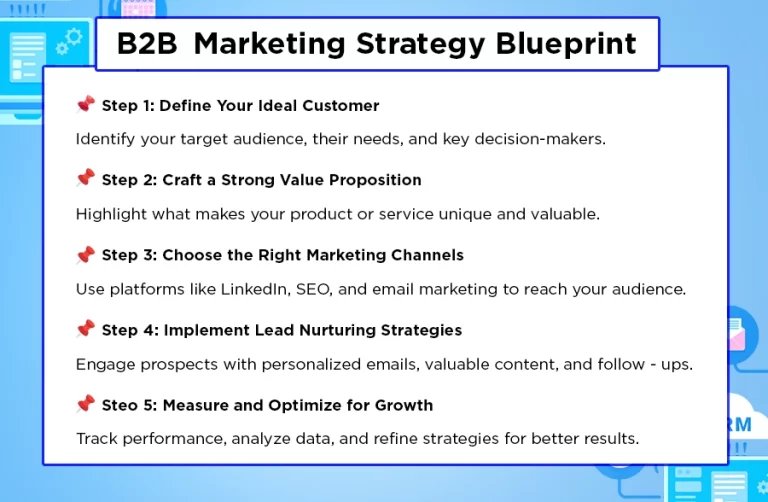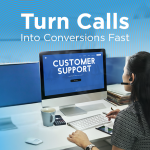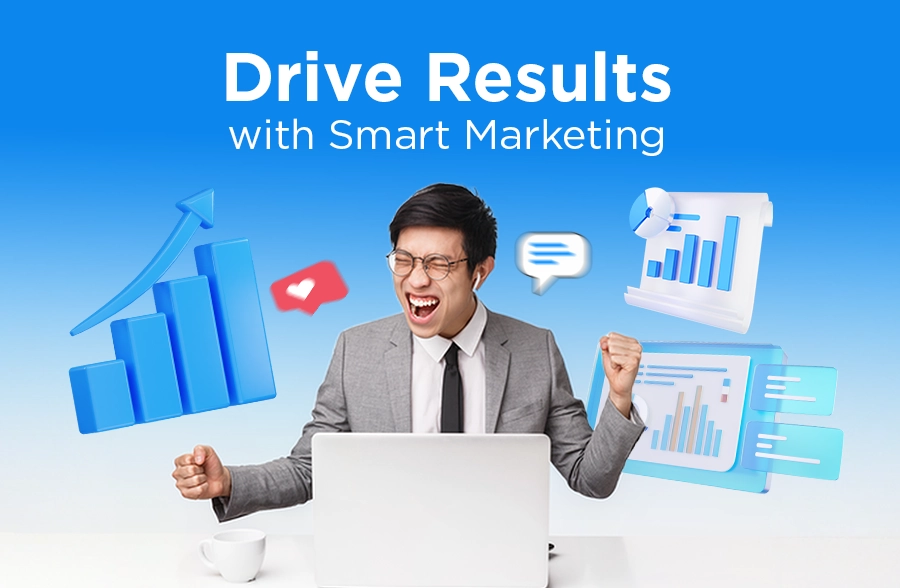Schedule a FREE call with our outsourcing expert now and get a precise quotation that meets your requirements. Don't wait - get started today!
B2B marketing is different from B2C marketing. Why? Because businesses make decisions based on logic, not emotions. Unlike consumers, they need facts, value, and long-term benefits.
But here’s the challenge—many companies still use generic marketing tactics. That’s a mistake.
Instead, B2B companies need a structured marketing strategy. A solid framework helps reach the right audience, increase conversions, and build lasting partnerships.
Let’s explore marketing strategies that work specifically for B2B companies.
1. Account-Based Marketing (ABM) for High-Value Clients
B2B sales cycles are long. They involve multiple decision-makers. That’s where ABM comes in. It helps companies target high-value clients with personalized marketing efforts.
How ABM Works:
- Identify key accounts – Focus on businesses that match your ideal customer profile.
- Personalize marketing efforts – Tailor content, emails, and ads to their specific needs.
- Align sales and marketing teams – Ensure both teams work together to nurture leads.
- Measure success – Track engagement, conversions, and deal closures.
ABM isn’t about mass marketing. It’s about quality over quantity. When done right, it increases deal sizes and strengthens client relationships.
2. Thought Leadership: Becoming an Industry Authority
Buyers trust experts. If you establish your brand as a thought leader, prospects will come to you for solutions.
Ways to Build Thought Leadership:
- Publish insightful content – Blog posts, whitepapers, and case studies attract decision-makers.
- Host webinars and podcasts – These platforms allow you to share expertise and engage with your audience.
- Leverage LinkedIn – This is the go-to platform for B2B networking and content sharing.
- Speak at industry events – Conferences and panels boost credibility and visibility.
Thought leadership isn’t about selling. It’s about educating and offering value. The more trust you build, the easier it is to convert leads into customers.
3. Data-Driven Marketing for Smarter Decisions
Numbers don’t lie. A strong marketing strategy is backed by data, not assumptions.
How to Leverage Data in B2B Marketing:
- Use analytics tools – Google Analytics, HubSpot, and CRM software to track customer behavior.
- Segment your audience – Create buyer personas based on company size, industry, and challenges.
- Optimize campaigns – Adjust strategies based on performance metrics like conversion rates and engagement.
- Predict trends – AI and machine learning can forecast customer needs and preferences.
A study found that 64% of marketing leaders strongly agree that data-driven strategies are key to growth. The takeaway? If you’re not using data, you’re missing opportunities.
4. Relationship-Based Selling: The Power of Trust
B2B sales are built on relationships. If clients trust you, they’ll choose you over competitors.
How to Build Strong Client Relationships:
- Provide valuable insights – Help clients solve problems, not just sell products.
- Offer exceptional support – Quick responses and proactive service build loyalty.
- Stay in touch – Regular follow-ups keep your brand top of mind.
- Be transparent – Honesty about pricing, features, and limitations builds credibility.
Relationship-building takes time, but it leads to repeat business and referrals. A strong connection with clients gives you a competitive edge.
5. Multi-Channel Marketing for Maximum Reach
Relying on one marketing channel isn’t enough. B2B buyers use multiple platforms before making a decision.
Effective Multi-Channel Strategies:
- SEO-driven content marketing – Helps attract organic traffic and leads.
- Email marketing – Keeps prospects engaged with personalized communication.
- Social media engagement – Platforms like LinkedIn, Twitter, and YouTube drive brand awareness.
- Paid ads and retargeting – Google Ads and LinkedIn Ads help reach the right audience.
A multi-channel approach ensures that no potential lead slips through the cracks. It also strengthens brand recall and trust.

6. Video Marketing: Engaging B2B Buyers Visually
Text-based content is essential, but video marketing captures attention faster and more effectively. A study found that 72% of B2B buyers watch videos to research products before purchasing.
How to Use Video in B2B Marketing:
-
Product demos & tutorials – Showcase how your solution works in a way that’s easy to understand.
-
Client testimonials – Video case studies build trust by highlighting real customer success stories.
-
Behind-the-scenes content – Give prospects a look at your company culture and expertise.
-
Live Q&A sessions – Engage with potential customers in real-time, answering their key concerns.
Videos simplify complex concepts and increase engagement, conversions, and trust.
7. Interactive Content: Boosting Engagement and Lead Generation
Buyers don’t just want to read—they want to engage. Interactive content makes marketing more dynamic and helps qualify leads.
Effective Interactive Content Formats:
-
Quizzes & assessments – Help prospects evaluate their needs.
-
ROI calculators – Show potential clients the savings or revenue boost your solution can provide.
-
Interactive eBooks & infographics – Encourage users to engage with data in a more digestible way.
-
Polls & surveys – Gather insights while keeping your audience engaged.
Interactive content improves engagement and makes your brand more memorable.
8. Influencer & Partner Marketing: Leveraging Industry Authority
Influencer marketing isn’t just for B2C—B2B buyers also trust recommendations from industry leaders. Collaborating with influencers or strategic partners can amplify your reach.
How to Implement Influencer & Partner Marketing:
-
Work with industry experts – Have them review or endorse your product.
-
Guest blogging & co-marketing – Partner with reputable brands to share audiences.
-
Affiliate & referral programs – Incentivize professionals to promote your services.
-
Collaborate on webinars & podcasts – Expand your audience through expert-led discussions.
Strategic partnerships help build credibility faster and tap into new audiences.
9. AI & Automation: Scaling Marketing Without Losing Personalization
Automation doesn’t mean losing the human touch—it means working smarter. AI-powered tools can streamline processes while ensuring personalized engagement.
Key AI & Automation Strategies:
-
Chatbots & AI assistants – Provide instant responses to customer inquiries.
-
Automated email sequences – Nurture leads without manual effort.
-
AI-driven content recommendations – Deliver personalized content based on user behavior.
-
Predictive analytics – Forecast trends and personalize marketing efforts.
AI and automation help businesses scale efficiently while enhancing customer experience.
10. Community Building: Turning Customers into Brand Advocates
A strong community creates brand loyalty and long-term engagement. B2B companies that build a following don’t just sell products—they create movements.
How to Build a B2B Community:
-
Launch exclusive LinkedIn or Slack groups – Give customers a space to network and discuss industry challenges.
-
Host AMAs (Ask Me Anything) and roundtables – Engage with your audience in open discussions.
-
Create user-generated content opportunities – Feature client success stories and contributions.
-
Offer early access & insider perks – Reward loyal customers with special offers.
A thriving community strengthens customer relationships, reduces churn, and boosts referrals.
Common Challenges in B2B Marketing and How to Overcome Them
B2B marketing comes with unique obstacles that require strategic solutions. Here are some of the most common challenges and how to address them.
1. Long Sales Cycles
Unlike B2C, B2B sales take time. Multiple decision-makers, budget approvals, and product evaluations slow the process. To overcome this, businesses should implement lead nurturing strategies through email marketing and retargeting.
Account-Based Marketing (ABM) can help personalize outreach for key accounts, while aligning sales and marketing teams ensures leads remain engaged throughout the buying process.
2. Generating High-Quality Leads
Not all leads are valuable, and many businesses struggle to attract prospects who are genuinely interested in making a purchase.
Data-driven marketing can refine audience targeting, while SEO and content marketing help attract relevant traffic. LinkedIn and industry-specific platforms can also be leveraged to connect with decision-makers and generate quality leads.
3. Differentiating from Competitors
B2B markets are saturated, making it difficult to stand out. Many companies offer similar products and services, which means having a strong brand identity and a clear value proposition is essential.
Thought leadership through authoritative content can position a company as an industry expert while providing exceptional customer experiences, building trust, and fostering long-term loyalty.
4. Creating Engaging Content
B2B content often leans toward the technical side, which can make it dry and unappealing to decision-makers. Storytelling and real-world applications of a company’s solutions make content more relatable and compelling.
Visual formats such as infographics and videos can simplify complex topics, while interactive content like quizzes or calculators increases engagement.
5. Adapting to Changing Buyer Behavior
B2B buyers now expect a digital-first experience similar to B2C. They conduct extensive research before making contact with a company. Optimizing websites with self-service resources like FAQs and case studies ensures prospects can find the information they need.
Chatbots and live chat features enable real-time engagement, while social proof, such as testimonials and customer success stories, builds credibility.
6. Measuring ROI Effectively
Proving the return on investment in B2B marketing can be challenging because results aren’t always immediate. Setting clear KPIs aligned with business goals ensures marketing efforts are measurable.
Marketing automation and analytics tools help track lead progression, while multi-touch attribution models provide a clearer picture of what drives conversions.














